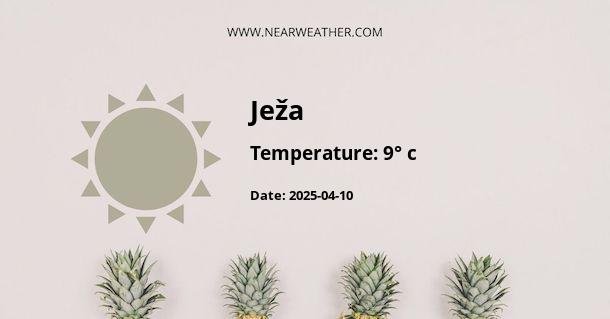Climate and Weather in Ježa, Slovenia
The small village of Ježa is situated in the picturesque country of Slovenia, a nation renowned for its varied topography and climate that ranges from the Alpine in the northwest to the Mediterranean in the coastal regions. Ježa, located in north-central Slovenia, experiences a climate that is somewhat transitional between these two major types, reflecting characteristics of both continental and sub-Mediterranean climates.
Seasonal Weather Patterns in Ježa
In Ježa, as in much of Slovenia, the seasons are distinct, each bringing its unique weather pattern that affects the daily life of its residents and visitors.
- Spring: Starting in March, the region begins to thaw from the winter chill with average high temperatures ranging from 10°C (50°F) to 20°C (68°F) by the end of May. Spring witnesses a gradual increase in precipitation, with April and May being particularly well-known for their higher rainfall.
- Summer: The summer months, from June to August, are generally warm with temperatures regularly reaching above 25°C (77°F) during the day. July is often the hottest month, and while there can be periods of dry weather, thunderstorms are not uncommon in the afternoons, due to the influence of the nearby Alpine region.
- Autumn: September marks the beginning of autumn in Ježa, with temperatures starting to dip and the landscape taking on the stunning hues of fall. Average high temperatures in September can still be around 20°C (68°F) but will cool down to about 10°C (50°F) by November. Rainfall is a common feature during autumn months as well.
- Winter: December through February is winter time, when Ježa often sees snow and colder conditions. Temperatures can frequently fall below freezing, especially during January, the coldest month. Snowfall varies from year to year but provides opportunities for winter sports in nearby locations.
Temperature and Precipitation Overview
Ježa's temperate climate reflects a general European continental influence with warm summers and cool winters, tempered slightly by Mediterranean flows.
| Month | Average High (°C) | Average Low (°C) | Precipitation (mm) |
|---|---|---|---|
| January | 2 | -4 | 70 |
| February | 5 | -2 | 60 |
| March | 10 | 1 | 80 |
| April | 15 | 5 | 90 |
| May | 20 | 10 | 100 |
| June | 25 | 14 | 120 |
| July | 27 | 15 | 100 |
| August | 27 | 15 | 110 |
| September | 20 | 10 | 100 |
| October | 15 | 6 | 120 |
| November | 8 | 2 | 130 |
| December | 3 | -2 | 100 |
Note: The data presented in the table above reflect average values based on historical weather records for the region of Ježa, Slovenia. Actual weather conditions can exhibit variability not captured in these averages.
Impact of Climate on Local Lifestyle and Economy
Residents of Ježa are accustomed to the diverse weather conditions that each season delivers and have adapted their activities accordingly. Agriculture, a key component of the local economy, follows a seasonal pattern that takes into account the periods of frost, precipitation, and warm temperatures. Crops are selected for their suitability to the cool, damp springs, and warm summers. Likewise, the wine industry in the nearby regions takes advantage of the suitable microclimates for the cultivation of grape varieties suited to the Slovenian weather patterns.
Winter sports, like skiing and snowboarding, are popular in Slovenia, with Ježa situated within proximity to some modest slopes and larger Alpine resorts that cater to these activities during the colder months. Slovenia's growing reputation as an ecotourism destination means that Ježa might be a stopping point for hikers and outdoor enthusiasts year-round.
Environmental and Climatic Challenges
As with many areas across Europe and indeed the world, Ježa faces certain challenges associated with climate change. Fluctuations in temperature and precipitation patterns can affect agricultural outputs and disrupt the natural balance of local ecosystems. Additionally, the potential for extreme weather events, such as severe storms or uncharacteristically warm winters, present ongoing challenges for both the inhabitants of Ježa and policymakers. Efforts to adapt and mitigate the effects of climate change are being considered at various levels of government and within communities themselves.
Weather Preparedness and Adaptation
Understanding the local weather patterns is crucial for preparedness and planning. Relevant stakeholders in Ježa, including farmers, urban planners, and individuals, need to be equipped with accurate weather forecasting and climate projection tools. This enables them to make informed decisions and implement strategies that will reduce vulnerabilities, whether it's planting drought-resistant crop variants or constructing infrastructure that can withstand extreme weather events.
Conclusion
The climate and weather in Ježa, Slovenia, bring with them a mixture of predictability and variability that can be seen across the seasons. Understanding these patterns is vital for the local economy, lifestyle, and future sustainability of the region. By taking proactive measures and adapting to the changing climate landscape, the people of Ježa can continue to thrive in their beautiful and dynamic environment.
A - Ježa's Latitude is 46.101669 & Longitude is 14.549720.
A - Weather in Ježa is -2° today.
A - Climate Conditions in Ježa shows mist today.
A - Humidity in Ježa is 93% today.
A - Wind speed in Ježa is 1.84 km/h. today.
